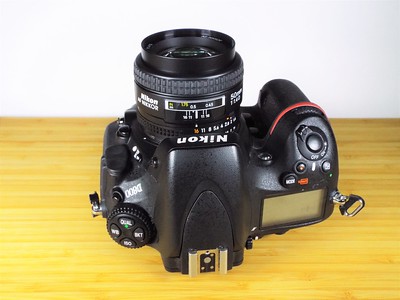Nikon D800

|
| A Nikon D800 with the optional MB-D12 Battery Grip and a Nikkor Nikkor 85mm f1.8 AF-D lens image by Titin Soriano (Image rights) |
The Nikon D800(E) is a full-frame professional digital SLR camera body which was announced by Nikon in February 2012 and released in March of that year. [1]. It features 4fps burst shooting, 1080p video at 30 and 24fps, an expanded ISO range of 50-25,600, and a 3.2" 921k dot screen. It uses the Multi-CAM3500FX autofocus sensor which has 51 AF points, 15 of which are cross type.
The D800(E) made headlines with its 36.3 megapixel 24x36 full-frame sensor which was ranked by Dxomark as the highest performing digital sensor at the time.[2].
Contents
D800E
The D800E was released in April 2012. It is mechanically the same as the D800 but the sensor did not include an anti-aliasing filter, increasing sharpness.
Reception
| Source | Review Score |
|---|---|
| CameraLabs | 87% |
| Dpreview | 82% (Gold award) |
| Photography Blog | 100% (Essential) |
| Thom Hogan | 90% |
| Dxomark | 95% |
| Expert Reviews | 80% |

|
| image by Chasing Classic Cameras with Chris (Image rights) |
Notes
- ↑ Nikon D800 and D800E 36MP full-frame DSLRs announced - Press release at Digital Photography Review
- ↑ Nikon D800E nabs top ranking from D800 - review at DxOMark
Links
| Japan Camera Grand Prix | |
|---|---|
| Camera of the year
1984: Nikon FA | 1985: Minolta α-7000 | 1986: Canon T90 | 1987: Canon EOS 650 | 1988: Kyocera Samurai | 1989: Nikon F4 | 1990: Canon EOS 10 | 1991: Contax RTS III | 1992: Pentax Z-1 | 1993: Canon EOS 5 | 1994: Minolta α-707si | 1995: Contax G1 | 1996: Minolta TC-1 | 1997: Nikon F5 | 1998: Pentax 645N | 1999: Minolta α-9 | 2000: Canon EOS-1V | 2001: Minolta α-7 | 2002: Canon EOS-1D | 2003: Canon EOS-1Ds | 2004: Nikon D70 | 2005: Konica Minolta α-7 Digital | 2006: Nikon D200 | 2007: Pentax K10D | 2008: Nikon D3 | 2009: Canon EOS 5D Mark II | 2010: Olympus Pen E-P1 | 2011: Pentax 645D | 2012: Nikon D800 | 2013: Sony DSC-RX1 | 2014: Nikon Df | 2015: Canon EOS 7D Mark II | 2016: Sony α7R II | 2017: Olympus OM-D E-M1 Mark II | 2018: Sony α9 | 2019: Lumix S1R | 2020: Sony α7R IV | 2021: Sony α1 | 2022: Nikon Z9 | 2023: Sony α7R V Special Prize Editor | |